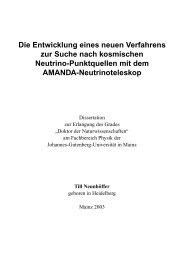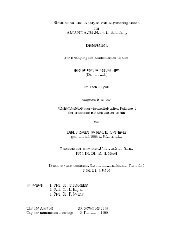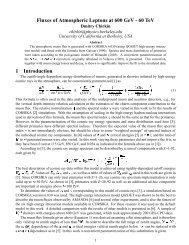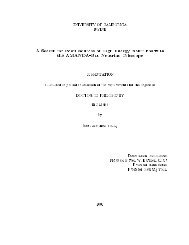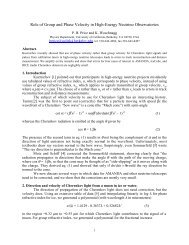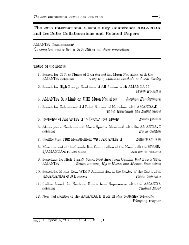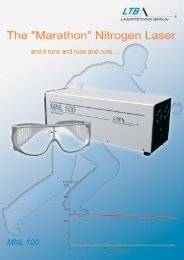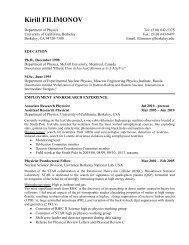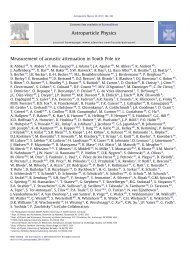Link to Fulltext
Link to Fulltext
Link to Fulltext
Create successful ePaper yourself
Turn your PDF publications into a flip-book with our unique Google optimized e-Paper software.
6 Calibration<br />
6.1 Time calibration<br />
During the first calibration phase, right after deployment at the South Pole, a YAG laser was<br />
used <strong>to</strong> measure all the time delays due <strong>to</strong> different cable-lengths and transit times in the<br />
<br />
PMs<br />
) which have <strong>to</strong> be subtracted from subsequent leading-edge measurements. An optical fiber<br />
( <br />
ending at an isotropizing nylon ball right below each OM was used <strong>to</strong> send light from the surface<br />
with the YAG-laser. The data thus acquired was then used <strong>to</strong> make the in-situ time-calibration<br />
of the detec<strong>to</strong>r. The distance between the nylon ball and the OM is typically less than a meter<br />
(much less than one scattering length in ice), so that we can safely assume that all hits are direct<br />
(unscattered).<br />
Since the pulses arriving at the surface have traveled through nearly 2000 meters of coaxial<br />
cable, they are very stretched, with typical t.o.t.’s of 550 ns and rise-times of 180 ns. The<br />
threshold used is set <strong>to</strong> the same value for all pulses and this means that small ones, with a slow<br />
rise-time, are measured as coming very late, compared <strong>to</strong> those with larger amplitudes.<br />
In order <strong>to</strong> account for that effect, a correction based on the measured ADC value is used<br />
(see Eq. 55 and Fig. 34).<br />
Trigger level<br />
A<br />
B<br />
Figure 33: Time-walk due <strong>to</strong> constant level discrimina<strong>to</strong>r<br />
This is the fit of the leading-edge versus ADC plots made, in order <strong>to</strong> be able <strong>to</strong> make timewalk<br />
corrections, i.e. <strong>to</strong> correct for differences in time measurements due <strong>to</strong> different pulse amplitudes<br />
(see Fig.<br />
£ <br />
33):<br />
¡£¢ ¢<br />
(55)<br />
where C is an arbitrary constant. An example of such a fit is shown in Fig. 34.<br />
In some data-taking runs, the TDC trigger level for several of the OMs was changed; this had<br />
also <strong>to</strong> be taken in<strong>to</strong> account. When the threshold on some PM was lowered from the 100 mV<br />
calibration value <strong>to</strong> a new value, the formula above had <strong>to</strong> be modified <strong>to</strong> the form:<br />
<br />
¢<br />
£ ¢ ¡<br />
¡<br />
¡ ¢<br />
(with <br />
, the new threshold, in mV). However, this fit is neither good for <strong>to</strong>o low ADC values,<br />
where noise becomes a concern, nor for <strong>to</strong>o large values, where saturation effects enter. Light<br />
cuts can be applied on the ADC values in an off-line analysis <strong>to</strong> improve the time measurements.<br />
This way, a time resolution ¥ of ns is achieved at the ¡ § gain voltage at which the detec<strong>to</strong>r is<br />
operated for normal data-taking (see Fig. 35).<br />
44<br />
(56)



